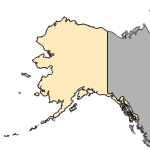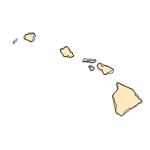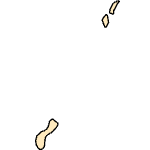Astatotilapia calliptera
(eastern happy)
Fishes
Exotic |
|
Common name: eastern happy
Synonyms and Other Names: Haplochromis callipterus (Günther 1894)
Taxonomy: available through
www.itis.gov
Identification: The eastern happy is a freshwater fish of the haplochromine cichlid species from southeastern Africa. The species has been described as having blue lips and a black to dark brown line that runs through the eye. Although this a common trait of Lake Victorian cichlids, males are usually greenish to yellow with red and blue highlights while females have a ‘subdued’ green-gray color (Tropical Fish Keeping 2025).
Size: Up to 15 cm SL (Eccles 1992)
Native Range: Africa: Lakes Chilwa, Chiuta, and Malawi; Lower Zambezi, Buzi, Pungwe, and Save River systems; Native to Malawi, Mozambique, Tanzania, Zambia, and Zimbabwe (USFWS 2018).



|

Alaska |

Hawaii |

Puerto Rico &
Virgin Islands |

Guam Saipan |
Hydrologic Unit Codes (HUCs) Explained
Interactive maps: Point Distribution Maps
Nonindigenous Occurrences:
Specimens were first collected from the Hillsboro Canal, Palm Beach County, Florida, in April 1998, and have been collected there sporadically through 2007 (Shafland et al. 2008). There has been no evidence for spread beyond that location.
Table 1. States with nonindigenous occurrences, the earliest and latest observations in each state, and the tally and names of HUCs with observations†. Names and dates are hyperlinked to their relevant specimen records. The list of references for all nonindigenous occurrences of Astatotilapia calliptera are found here.
Table last updated 1/13/2026
† Populations may not be currently present.
Ecology: The species inhabits shallow, vegetated nearshore areas in lakes (Parsons et al. 2017), and adjacent streams or rivers (Konings 1990; Eccles 1992). The species is considered a generalist (Parsons et al. 2017). It consumes a variety of prey, including benthic invertebrates, algae, and small fishes (Konings 1990). The species is a mouth-brooding guarder and uses a variety of substrates (Lawson 2018). Its preferred spawning temperature is 26°C (Lawson 2018). The length of the spawning season is 3 months, and parental energetic contribution is ranked as a 4 according to Winemiller’s (1989) index (Lawson 2018). The time to egg hatch is approximately 288 hours, and the species has very low salinity tolerance and is non-migratory (Lawson 2018).
Means of Introduction: Likely aquarium release.
Status: Unknown. Persistence over ~10 years and variable catch rates among years indicates that this species has reproduced (Shafland et al. 2008). However, a lack of reported specimens since 2007 suggests that this species may be extirpated from Florida.
Impact of Introduction: Unknown. Lawson (2018) ranked the species according to its impacts, with an overall score of zero.
References: (click for full references)
Eccles, D.H. 1992. FAO species identification sheets for fishery purposes: field guide to the freshwater fishes of Tanzania. Food and Agriculture Organization of the United Nations, Rome, Italy. http://www.fao.org/docrep/010/t0605e/t0605e00.htm.
Konings, A. 1990. Koning's book of cichlids and all the other fishes of Lake Malawi. Tropical Fish Hobbyist Publications, Neptune City, NJ.
Lawson, K.M. 2018. Use of life history traits to predict invasion success of non-native fishes in Peninsular Florida. University of Florida.
Parsons, P.J., Bridle, J.R., Rüber, L., and Genner, M.J. 2017. Evolutionary divergence in life history traits among populations of the Lake Malawi cichlid fish
Astatotilapia calliptera. Ecology and Evolution 7(20):8488-8506.
Shafland, P.L., K.B. Gestring, and M.S. Stanford. 2008. Florida's exotic freshwater fishes - 2007. Florida Scientist 71(3):220-245.
Tropical Fish Keeping. 2025. https://tropical-fish-keeping.com/eastern-happy-astatotilapia-calliptera.html. Accessed 04 Apr 2025.
Turner, G.F., Ngatunga, B.P., and Genner, M.J. 2021.
Astatotilapia species (Teleostei, Cichlidae) from Malawi, Mozambique and Tanzania, excluding the basin of Lake Victoria. https://doi.org/10.32942/osf.io/eu6rx.
USFWS (United States Fish and Wildlife Service). 2018. Eastern Happy (
Astatotilapia calliptera) Ecological Risk Screening Summary. https://www.fws.gov/sites/default/files/documents/Ecological-Risk-Screening-Summary-Eastern-Happy.pdf. Accessed 07 Apr 2025.
Winemiller, K.O. 1989. Patterns of variation in life-history among South American fishes in periodic environments. Oecologia 81:225-241.
Author:
Dean, EM, M.E. Neilson, and P. Fuller
Revision Date: 4/21/2025
Peer Review Date: 4/21/2025
Citation Information:
Dean, EM, M.E. Neilson, and P. Fuller, 2026, Astatotilapia calliptera (Günther, 1894): U.S. Geological Survey, Nonindigenous Aquatic Species Database, Gainesville, FL, https://nas.er.usgs.gov/queries/FactSheet.aspx?speciesID=2597, Revision Date: 4/21/2025, Peer Review Date: 4/21/2025, Access Date: 1/13/2026
This information is preliminary or provisional and is subject to revision. It is being provided to meet the need for timely best science. The information has not received final approval by the U.S. Geological Survey (USGS) and is provided on the condition that neither the USGS nor the U.S. Government shall be held liable for any damages resulting from the authorized or unauthorized use of the information.